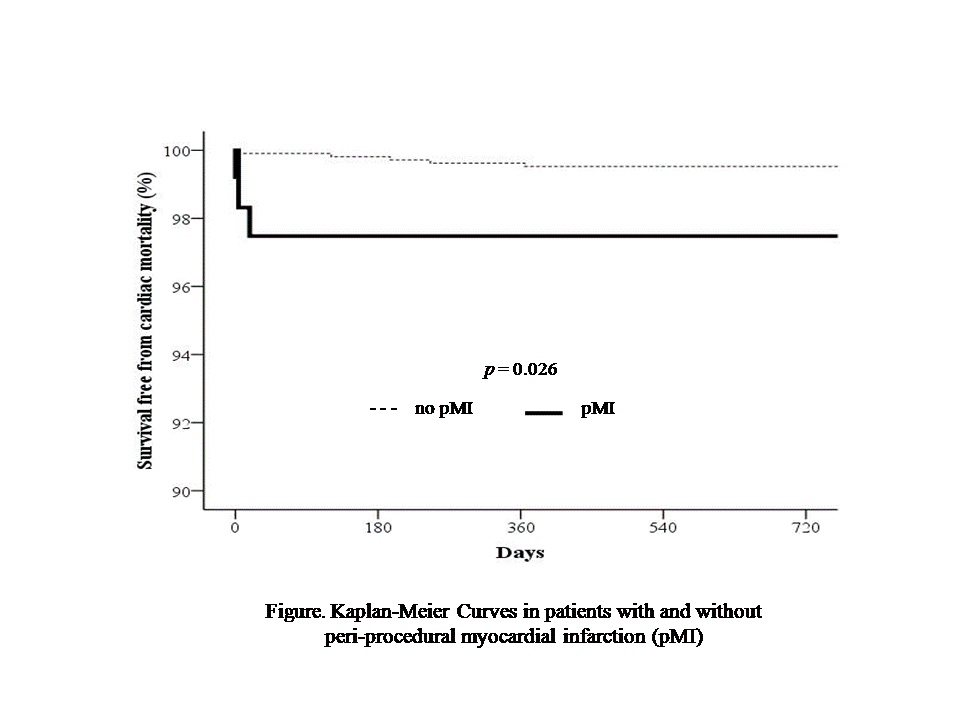| єя«•«ьљƒ : ±Єњђ
|
ЅҐЉцєш»£ - 540520 343 |
| Peri-procedural myocardial infarction was not associated with increased risk of long term cardiac mortality after bifurcation stenting |
| мД±кЈ†кіАмЭШлМА мВЉмД±мДЬмЪЄл≥СмЫР¬є, м†ДлВ®лМАл≥СмЫР ¬≤, мДЬмЪЄлМАнХЩкµРл≥СмЫР¬≥, мґ©лВ®лМАнХЩкµРл≥СмЫРвБі |
| мЖ°нХДмГБ¬є, мЖ°мШБлєИ¬є, нХЬм£ЉмЪ©¬є, мµЬмКєнШБ¬є, мµЬмІДнШЄ¬є, мЭімГБнЫИ¬є, кґМнШДм≤†¬є, м†Хл™ЕнШЄ¬≤, кєАнЪ®мИШ¬≥, мД±мЭЄнЩШвБі |
Backgrounds Although previous studies reported that peri-procedural myocardial infarction (pMI) was a risk factor for long term mortality, there have been arguments pMI may be the marker of high risk percutaneous coronary intervention (PCI) rather than risk factor. The aim of this study was to evaluate the prognostic significance of pMI in rather homogenous group bifurcation stenting. Methods Among the patients included in Coronary Bifurcation Stenting registry, patients with available post-PCI peak creatine kinase-myocardial band (CK-MB) level were included (71% of patients). Patients with myocardial infarction (MI) at presentation were excluded. pMI was defined as a peak CK-MB value вЙ• 3 times of the upper limit of normal. Results Total 1,188 patients were included in the analysis. The incidence of pMI was 8.7% during the median follow-up of 22.7 months. Patients with pMI were older, more likely to have unstable angina at presentation, had lower left ventricular ejection fraction on echocardiography, more likely to have multi-vessel disease and non-left anterior descending coronary artery location. In the survival analysis, pMI was associated with an increased risk for cardiac mortality (p=0.026). The difference was noted during first month in the Kaplan-Meier curve (Figure). However, multivariate analysis using Cox Hazard model (adjusting age, history of prior MI, history of cerebrovascluar accident, unstable angina at presentation, creatinine > 2.0 mg/dl, multivessel disease, thrombus in parent vessel, and thrombus in side branch) showed no significantly increased risk of cardiac death in the pMI group (p=0.25). Conclusions After bifurcation stenting, a pMI was not associated with increased risk of long term cardiac mortality after risk factor adjustment, which suggests that pMI may be the marker of high-risk PCI rather than the risk factor for long-term cardiac mortality.
|
|
|
Warning: getimagesize(/home/virtual/circulationadmin/renewal/econgress/conference/abstract/img_files/pMI_COBIS.gif) [function.getimagesize]: failed to open stream: No such file or directory in /home/virtual/circulationadmin/new/econgress/conference/manage/schedule/view_abstract.php on line 164

|
|





